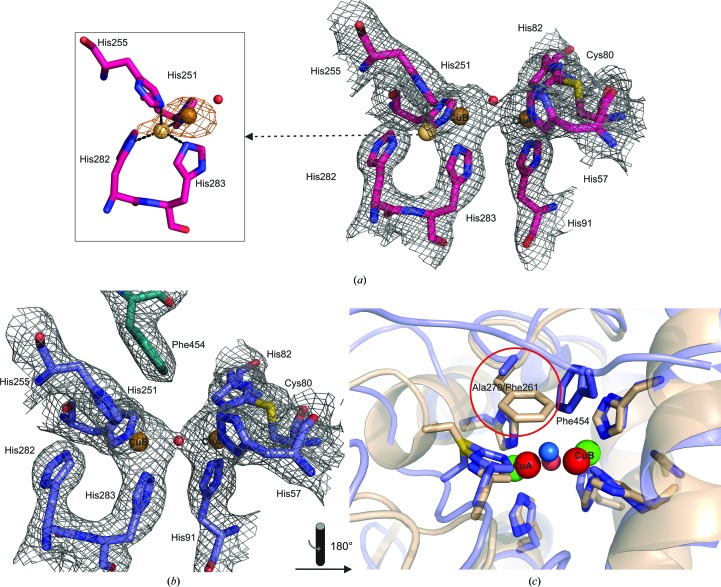Figure 5.
Active site of L-TYR and A-TYR abPPO4. Colour code: A-TYR, purple; L-TYR, blue; copper ion, bronze (alternative conformation, light bronze); 2mF o − mF c electron-density mesh (0.63 e Å−3, 1.5 r.m.s.d.), grey; anomalous electron-density mesh (0.40 e Å−3, 3 r.m.s.d.), orange; catechol oxidase from I. batatas, beige; L-TYR abPPO4 copper ions, green; respective superimposed ibCO copper ions, red. (a) Active site of A-TYR lacking the protruding Phe454 (C-terminal domain) with a copper distance of 4.2 Å. A water molecule (Wat128, ocupancy 0.90, B = 42.65 Å2) is bridging the two copper ions in a triangular position (CuA–Wat = 2.4 Å; Wat–CuB = 2.3 Å). CuB shows an alternative conformation in the vicinity of His282 (CuB1–CuB2 = 2.3 Å). His255, His251, His282 and His283 are coordinating the weakly occupied alternative CuB site (CuB1, occupancy 0.92, B = 30.62 Å2; CuB2, occupancy 0.08, B = 29.31 Å2) in a tetrahedral conformation (Cu—N∊/δ = 2.1–2.2 Å). The inset shows the anomalous scattering electron-density map, which clearly exhibits a hump towards His282. Thus, positional flexibility of the CuB site is indicated. Notably, His282 in (a) is side-chain flipped compared with (b). (b) Latent active site of L-TYR showing defined electron density at both copper-binding sites. A water molecule (Wat129, occupancy 0.95, B = 32.90 Å2) is bridging the copper (CuA–CuB = 4.7 Å) spheres positioned directly on a line between the two ions (CuA–Wat = 2.3 Å; Wat–CuB = 2.3 Å). (c) Superimposition of the active site of L-TYR abPPO4 and catechol oxidase from I. batatas. The CuA site-blocking bulky residue (Phe261) in ibCO is substituted by the less bulky alanine residue (Ala270) in L-TYR abPPO4.

